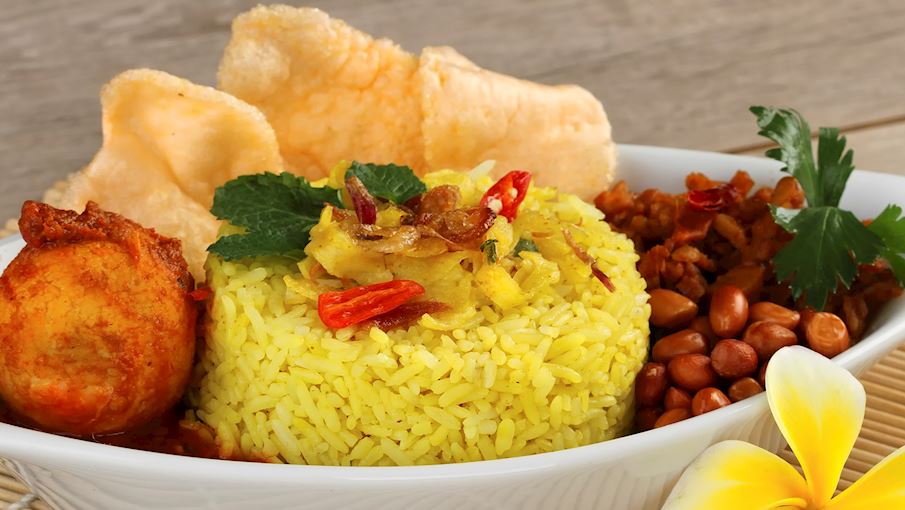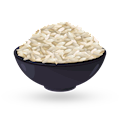MAIN INGREDIENTS
This traditional Indonesian dish consists of rice cooked in coconut milk that is usually seasoned with turmeric, lemongrass, and kaffir lime leaves. Even though yellow rice is the star of nasi kuning, the dish is assembled out of other Indonesian dishes and complements, such as fried chicken, potato fritters, sliced omelet, fried anchovies, shrimps, or fried tempeh.
Sambal, the traditional Indonesian chili sauce, and serundeng (spicy fried coconut flakes) are often served as condiments. Nasi kuning is always served neatly organized on the plate, and the rice should always be placed in the middle. It is traditionally associated with the island of Java, which is considered to be the place of origin of this authentic Indonesian dish.
MOST ICONIC Nasi kuning
View moreMAIN INGREDIENTS
Tempeh mendoan is a variety of fried tempeh that hails from Purwokerto. Thin slices of tempeh—fermented soybean product—are dipped in batter that is enriched with ground coriander, sliced scallions, and garlic before they are deep-fried.
This tempeh variety is only shortly fried, creating a crispy outer layer, while the tempeh remains soft and juicy. The name of the dish stems from Banyumasan language in which mendo roughly translates as half-cooked. This tempeh is best served with sambal, other types of chili-based dips, or kecap manis—Indonesian sweet soy sauce.
MAIN INGREDIENTS
This quintessential Southeast Asian condiment is usually made only with spicy chili peppers and salt. It is occasionally adapted with lime juice, onions, sugar, ginger, shrimp paste, or vinegar. Traditionally prepared in a mortar, it is characterized by its thick consistency and an incredibly strong and sharp flavor.
This original Indonesian creation has gained worldwide acclaim, and store bought varieties are available at numerous Asian food markets and international stores around the world. Sambal is used in a variety of Asian dishes, usually as a spicy condiment, seasoning, or a topping served alongside meat, seafood, vegetables, or rice.
MAIN INGREDIENTS
Tumis kangkung is a traditional dish originating from Java. The dish is usually made with a combination of kangkung (water spinach), shallots, garlic, galangal, hot chili peppers, sugar, salt, oil, and roasted shrimp paste. The garlic, shallots, hot chili peppers, shrimp paste, and galangal are sautéed in oil, then seasoned with salt and sugar.
Chopped water spinach is then added to the pan and the combination is stir-fried until the vegetable becomes tender. The dish can be served as a standalone meal or as an accompaniment to other foods.
Nasi timbel is a traditional rice dish originating from West Java. This extremely simple nasi dish is made with rice that's wrapped in a banana leaf, then steamed until tender. Nasi timbel is rarely eaten on its own – instead, it's served with various hot dishes and sides such as fried chicken, fried fish, tofu, tempeh, vegetables, soups, or sambal.
Urap or urap sayur (Bali) or urab is a traditional salad that's commonly associated with Java. The salad is made with a combination of steamed or boiled vegetables and spiced grated coconut topping. The vegetables included in urap are usually water spinach, bean sprouts, spinach, papaya leaves, cassava leaves, green beans, and cabbage.
The topping is prepared by cooking grated coconut with aromatic herbs and spices such as kaffir lime leaves, coconut sugar, tamarind, chili peppers, galangal, shallots, and garlic. Urap is typically served as an accompaniment to other dishes such as nasi kuning, ayam goreng, ayam penyet, and nasi tumpang.
MAIN INGREDIENTS
Lalap or lalab is a traditional salad originating from West Java. Although there is no set recipe for the salad, it's often made with raw vegetables such as tomatoes, lemon basil, green eggplants, cucumbers, cabbage, and long beans, along with blanched or boiled chayote, spinach, papaya leaves, water spinach, and cassava leaves.
The salad is served cold or at room temperature, and it's always accompanied by sambal terasi dipping sauce. Lalap can also be served as a side dish with pepes, fried fish, and fried chicken.
MAIN INGREDIENTS
Kuluban is a traditional salad originating from Jepara, Central Java. The salad is made with a combination of vegetables such as jackfruit, bean sprouts, spinach, garlic, galangal, string beans, orange leaves, and kencur ginger, along with shredded coconut, salt, sugar, chili peppers, and shrimp paste.
The vegetables are stir-fried with the spices, and the dish is then served warm. Kuluban is often eaten as a stir-fried salad, but it's also used as an accompaniment to meat dishes.
MAIN INGREDIENTS
Lontong is a traditional Indonesian rice cake, made by boiling tightly packed rice in banana leaves until it forms a firm, compact texture. The result is a mildly fragrant, chewy, and slightly firm rice cake, which is then sliced into bite-sized pieces and served as a staple carbohydrate in many Indonesian, Malaysian, and Singaporean dishes.
Unlike steamed rice, lontong has a more cohesive texture, making it ideal for soaking up rich, flavorful sauces. The process of making lontong involves partially cooking rice, packing it into banana leaf cylinders, and then boiling it for several hours.
TasteAtlas food rankings are based on the ratings of the TasteAtlas audience, with a series of mechanisms that recognize real users and that ignore bot, nationalist or local patriotic ratings, and give additional value to the ratings of users that the system recognizes as knowledgeable. TasteAtlas Rankings should not be seen as the final global conclusion about food. Their purpose is to promote excellent local foods, instill pride in traditional dishes, and arouse curiosity about dishes you haven’t tried.









